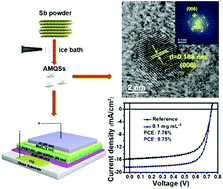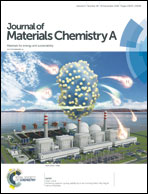High-yield production of stable antimonene quantum sheets for highly efficient organic photovoltaics†
Abstract
High-performance organic photovoltaics (OPVs) are of great scientific and technological importance due to their potential large-scale industrial applications. Introducing semiconductor quantum dots has been proven to be an effective way to improve the power conversion efficiency (PCE) of OPVs. In this paper, we report a novel approach to fabricate atomically thin antimonene quantum sheets (AMQSs) possessing a uniform size (≈2.2 nm) via imidazolium ionic liquid-assisted exfoliation. In this method, the yield of AMQSs (1.1 mg mL−1) has been increased by nearly two orders of magnitude compared with that of previously reported methods. Furthermore, upon adding AMQSs into the light absorber in OPVs, the optimal device with 1.0 mg mL−1 AMQSs shows the highest PCE of 9.75%, resulting in over 25% enhancement in PCE compared to that of the reference device. It also leads to a noticeable enhancement in the short-circuit current density (Jsc) of 16.7% and the fill factor (FF) of 8.4%. The increased PCE is mainly due to the two-dimensional electronic structure of AMQSs that can enhance the light absorption, assist exciton dissociation and reduce charge recombination of OPVs. This work provides a new avenue toward mass production of two-dimensional quantum sheets and points to a new strategy for highly efficient OPVs.



 Please wait while we load your content...
Please wait while we load your content...